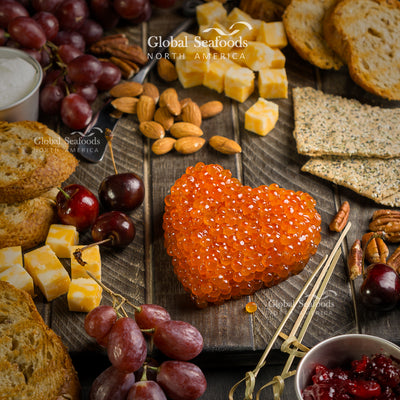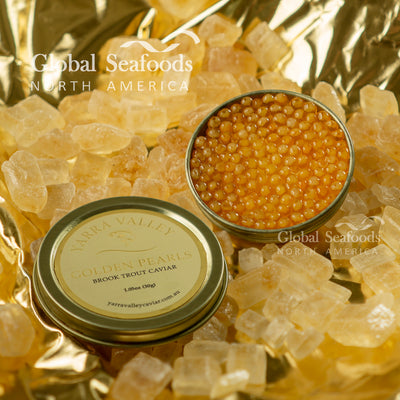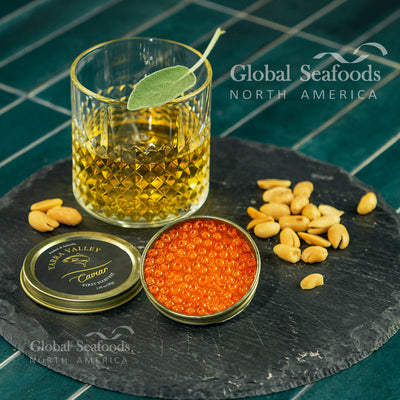The Secret to Storing Red Caviar: Keep It Fresh for Longer

Storing Red Caviar
Red caviar, a luxurious delicacy often sourced from salmon and trout, offers an explosion of briny, savory flavors. Its unique texture and taste make it a favorite among seafood lovers worldwide. However, to enjoy red caviar at its finest, proper storage is essential. Mishandling can lead to rapid spoilage, ruining its delicate flavor and texture.
In this comprehensive guide, we’ll uncover the secrets to storing red caviar, helping you preserve its freshness and quality for longer periods. Whether you’re savoring Coho Salmon Caviar from Global Seafoods or indulging in the delicate Rainbow Trout Pearls from Global Seafoods, the storage techniques outlined here will help maintain the best quality possible.
Why Proper Caviar Storage Matters
Caviar is a perishable product, and improper storage can significantly affect its taste, texture, and safety. Without the correct environment, red caviar can spoil quickly, becoming mushy or developing an off-putting odor.
As the famous French chef Paul Bocuse once said, "The secret to great cuisine is freshness." This principle is especially true for caviar. To maintain the delicacy's natural brininess and texture, it’s crucial to handle and store it with care. Here's how.
How Long Does Red Caviar Last?
One of the first things to understand is the shelf life of red caviar. Unopened red caviar can typically last 4-6 weeks if properly refrigerated. Once opened, however, it should be consumed within 3-5 days to ensure the best flavor and quality.
Factors Affecting Caviar Shelf Life:
- Type of Caviar: Different species of fish produce different caviars, each with its own unique storage needs. For example, Chum Salmon Caviar from Global Seafoods is often more delicate than other varieties and requires careful handling.
- Packaging: The original vacuum-sealed packaging helps to maintain freshness by preventing oxygen from reaching the product. Once this seal is broken, the caviar's shelf life decreases significantly.
- Storage Temperature: Cold temperatures are crucial to preserving caviar. Warm environments can encourage bacterial growth, which can spoil your caviar quickly.
Refrigeration: The Key to Freshness
The most reliable way to store red caviar is in the refrigerator, ideally between 28°F and 32°F. This temperature range is colder than the average home fridge, which typically operates at 40°F. For home storage, the coldest part of your fridge—usually the back of the bottom shelf—should be used for keeping caviar.
Expert Tip:
For optimal freshness, place your caviar container inside a shallow dish filled with ice and change the ice regularly to maintain a cold environment. This trick mimics the conditions of professional cold storage and can help extend the life of your caviar.
Example:
For premium products like Pink Salmon Caviar, maintaining a consistent cold temperature ensures that you get the most out of the delicate roe, retaining both flavor and texture.
Can You Freeze Red Caviar?
While fresh red caviar is best enjoyed within a few days of opening, freezing it is possible for those who want to store it for longer. However, freezing can alter the texture of the caviar, causing the eggs to burst and lose their signature "pop."
Freezing Guidelines:
- Use an Airtight Container: If you plan to freeze caviar, transfer it into a small, airtight container or vacuum-seal it to avoid exposure to air.
- Label the Container: Always label your container with the date you are freezing the caviar to ensure you keep track of how long it has been frozen.
- Short-Term Freezing Only: Caviar should not be frozen for longer than two months. After this period, the texture will degrade significantly, impacting your overall enjoyment of the product.
Once defrosted, the caviar should be eaten immediately and never refrozen. Products like Bloody Shiraz Infused Caviar from Global Seafoods offer such a high-quality flavor that freezing may detract from the unique notes and texture, so it’s recommended to consume these more specialized products while fresh.
Best Storage Containers for Red Caviar
The container you choose for storing caviar is as important as the refrigeration process. Proper containers keep the air out, preventing oxidation and maintaining moisture levels.
Ideal Containers for Caviar:
- Glass Jars: Glass is one of the best materials for storing caviar because it is non-reactive, meaning it won't impart any flavors to the delicate roe.
- Plastic Containers: Many commercially available caviars are packaged in plastic, which is fine for short-term storage. Just make sure it’s food-safe and airtight to maintain the integrity of the caviar.
- Metal Tins: Traditional caviar is often sold in metal tins, which are vacuum-sealed to keep the product fresh. If you’ve opened a tin of Golden Pearls Brook Trout Caviar from Global Seafoods, transfer any leftovers into a glass jar for longer-term storage.
Avoid These Common Caviar Storage Mistakes
Even seasoned caviar enthusiasts can make mistakes when it comes to storage. Avoid these common pitfalls to ensure you’re getting the best experience with your red caviar:
1. Storing Caviar at Room Temperature
Caviar should never be stored at room temperature, even for short periods. Warm temperatures encourage bacterial growth, which can lead to spoilage in as little as a few hours. Always keep your caviar chilled, whether it’s unopened or already in use.
2. Leaving the Seal Broken
Once the vacuum-sealed packaging has been opened, it’s important to tightly reseal the caviar to prevent exposure to air. Exposure to oxygen can cause the caviar to oxidize, leading to off flavors and a mushy texture.
3. Using Spoons Made of Reactive Materials
Caviar should never be served or stored using metal utensils made from materials like stainless steel or silver, as these metals can react with the roe, imparting an unpleasant metallic taste. Instead, opt for non-reactive materials like mother-of-pearl, bone, or wood spoons for both serving and storing purposes.
How to Tell If Red Caviar Has Gone Bad
Even with proper storage, caviar can sometimes spoil. Knowing the signs of spoilage is crucial in avoiding foodborne illness and ensuring the best possible taste experience.
Signs of Spoiled Caviar:
- Off Odor: Fresh caviar should smell briny and like the ocean. If it has a sour or ammonia-like smell, it has gone bad.
- Change in Texture: Good caviar should be firm and have a satisfying “pop” when eaten. If the eggs have turned mushy or slimy, they are no longer safe to consume.
- Discoloration: Fresh red caviar will have a consistent, vibrant color. If you notice patches of discoloration, this is a sign the product has spoiled.
Conclusion: Store Your Red Caviar Like a Pro
Whether you're indulging in a jar of Salmon Caviar from Global Seafoods or experimenting with the rich flavors of Trout Red Caviar from Global Seafoods, proper storage is key to preserving the delicate and exquisite nature of this luxury food. By following these expert tips on refrigeration, freezing, and container selection, you’ll ensure that your caviar remains fresh, flavorful, and ready to impress at your next gathering.
FAQs: Red Caviar Storage
1. How long does red caviar last after opening?
Once opened, red caviar should be consumed within 3-5 days for optimal freshness.
2. Can you freeze red caviar?
Yes, red caviar can be frozen, but it’s recommended to consume it fresh for the best texture and flavor.
3. How should I store red caviar in the refrigerator?
Store red caviar in the coldest part of your fridge (between 28°F and 32°F) and keep it in an airtight container to maintain freshness.
4. Can I use a regular metal spoon with red caviar?
No, it’s best to avoid reactive metal utensils like silver or stainless steel, as they can affect the flavor. Opt for a mother-of-pearl or bone spoon instead.
5. What’s the best way to serve caviar at a party?
Keep the caviar chilled by serving it over ice in a glass or non-reactive bowl to preserve its texture and flavor.
6. What is the ideal temperature to store caviar?
The ideal storage temperature for red caviar is between 28°F and 32°F, colder than the standard home refrigerator.
For more seafood storage tips and delicious recipes, be sure to check out the Global Seafoods YouTube Channel, where you’ll find helpful videos on making the most of your caviar and other premium seafood products.
Also in News

Columbia River Steelhead | Life Cycle, Conservation & Facts
Columbia River steelhead are one of the most resilient salmonid species, embarking on an incredible migration from freshwater to the ocean and back. Learn about their spawning habits, juvenile development, oceanic journey, and conservation efforts. Discover why steelhead are a prized fish for both anglers and seafood lovers.

Mastering Dover Sole: Cooking & Serving Guide for a Gourmet Experience
Dover Sole is a culinary delight known for its mild flavor and tender texture. Whether you're pan-frying for a crispy finish, baking for a healthy meal, or grilling for a smoky touch, this guide provides expert tips on preparing, cooking, and serving Dover Sole. Elevate your seafood dishes and enjoy gourmet flavors at home.

Cocktail Caviar Pairings: Best Drinks to Complement Exquisite Caviar
Pairing caviar with the right cocktail enhances both flavors, turning any occasion into an indulgent experience. Learn expert tips on pairing champagne, martinis, Moscow mules, and more with the perfect caviar selection.










